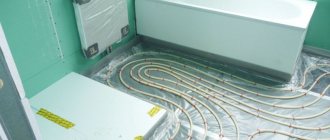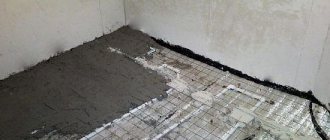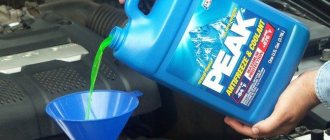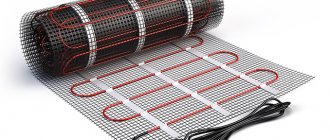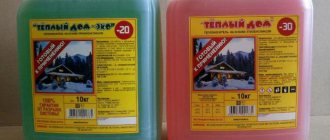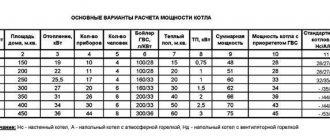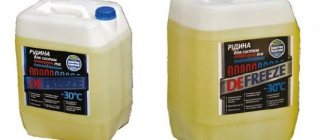Coolant "Warm House" is an inexpensive, non-hazardous and high-quality composition intended for heating systems. In addition, it is not only able to protect the equipment used, but also a safe, environmentally friendly product. It contains protective components that increase its ability to resist scale formation, there is almost no foam formation and the composition is able to slow down corrosion.
What is antifreeze?
Antifreeze is a chemical solution that, unlike water, does not freeze at temperatures below 0 degrees Celsius.
When water freezes, it expands and can rupture heating pipes, radiators, and damage plumbing fixtures, for example, a siphon under the sink or a toilet.
Important! Antifreeze , depending on the chemical composition, will not freeze at temperatures below -30...-65 ° C. At lower temperatures, the substance does not harden, but turns into a jelly-like form.
Application of compositions
The coolant of this brand is a liquid and is more fluid than water. For this reason, it is necessary to install the heating efficiently, after which the system must be pressure tested. Do not forget that it is prohibited to pour this liquid into electrolysis boilers.
Before use, most “Warm House” compositions are diluted with technical or distilled water. After dilution by 10%, its crystallization temperature increases to -25 degrees; if you dilute it to 20%, the characteristics of the solution will change to -20 degrees. After some time of operation, the coolant will begin to become jelly-like. If you dilute it with water at this time, the solution will restore its characteristics.
It is necessary to install the heating efficiently, after which the system must be pressure tested
Recipe for mixing 100 liters of coolant
“Warm Home” is often sold as a concentrate, which must be diluted before use. The proportions of the components affect the characteristics of the final solution (freezing point). If you add 23 liters of water to 77 liters of concentrate, the freezing point of the resulting solution will be about -40 degrees.
By dissolving 35 liters of water in 65 liters of concentrate, you will get a solution that can freeze only at -30 degrees. Adding 40 liters of water to 60 liters of concentrate will give you a mixture that will freeze at 25 degrees below zero. If the frost in your region is no more than 20 degrees, then you need to dilute 54 liters of concentrate with 46 liters of water.
In the equipment, all joints are treated with sealing compounds that are well resistant to the effects of glycol mixtures, or flax is used for this purpose. After the end of its service life, the solution still freezes only at low temperatures, but its anti-corrosion properties are significantly deteriorated.
For this reason, after the end of its useful life, the coolant must be drained and disposed of. Before filling the system with a new solution, be sure to check all components for leaks and completely flush the heating system.
After the end of its service life, the solution still freezes only at low temperatures, but its anti-corrosion properties are significantly deteriorated
How are they different from each other? I heard that ethylene glycol is poisonous, is this true?
Ethylene glycol is a hydrocarbon-based chemical compound – a dihydric alcohol. Ethylene glycol is a clear, slightly oily, colorless, odorless liquid.
Ethylene glycol, according to the degree of impact on the human body, belongs to substances of the 3rd hazard class. If ethylene glycol enters the body, it can be fatal. Ethylene glycol vapors are also dangerous, especially if inhaled for a long time.
Propylene glycol , like ethylene glycol, is a colorless and viscous liquid. But, unlike ethylene glycol, propylene glycol is not a toxic substance! It is used in perfumery and in the food industry as an additive E-1520. The use of propylene glycol is permitted in most EU countries.
Main characteristics of antifreeze
A number of non-freezing liquids “Warm House” contain products based on ethylene glycol and propylene glycol.
Both types of coolants are created according to environmental safety rules. Antifreeze does not freeze even at critical temperatures, so you can safely leave the house unattended for the weekend. The solution does not harm rubber, metal-plastic, plastic and flax. Read also: types of antifreeze for heating systems of private houses.
Model line
For the convenience of consumers, the manufacturer has presented several types of antifreeze.
In this video we will look at the types of antifreeze “Warm House”: The model line includes the following products:
- ECO-20. Green non-freezing liquid. The solution is based on propylene glycol. Can be used for two types of heating equipment, but is primarily produced for double-circuit boilers.
- Series 30. Red composition based on ethylene glycol. Ideal for single-circuit systems, but can also be used for dual-circuit equipment. The solution should be diluted with water according to the instructions. This antifreeze cannot be used in its pure form.
- ECO-30. Green solution with propylene glycol. Before use, the composition should be diluted with water to -20°C.
- Episode 60. Red liquid with a high content of ethylene glycol. The manufacturer recommends mixing antifreeze with water down to -20...-30°C.
Advantages and disadvantages
All types of Warm House antifreeze have their pros and cons.
The following advantages of this product can be highlighted:
- Wide range of temperature modes from -30 to +106°C.
- Long service life (from 5 to 8 years).
- Safety for heating system, prevent leakage with good sealing.
- Environmentally friendly, no toxic fumes during weathering.
- Absolute fire safety.
Any tool has its drawbacks. Antifreeze "Warm House" is no exception. Users highlight the following disadvantages:
- Antifreeze liquids are only suitable for gas heating. The solutions cannot be used in heating equipment with an electric boiler.
- Some types of antifreeze contain a high concentration of salt. This may contribute to the formation of scale.
- To achieve the desired effect, you need to mix the solution and water exactly according to the instructions. Failure to follow recommendations may result in carbon deposits.
The liquid must not be mixed with other antifreezes. When diluted, the additive package loses its properties. Moreover, dilution neutralizes the anti-corrosion effect.
Why are antifreezes for the heating system better than water, and why are they worse?
We have already said above that antifreeze, when the heating system freezes, will not freeze, which means it will not damage the engineering system of a country house. Perhaps this is where their advantages end. Let's compare the physicochemical properties of propylene glycol and water.
- The specific heat capacity of propylene glycol is 2483 J/(kg*K). The heat capacity of water is 4183 J/(kg*K).
That is, the heat capacity of propylene glycol is almost two times lower than that of water.
- The thermal conductivity of propylene glycol is 0.218 W/(m*K). Thermal conductivity of water is 0.6 W/(m*K).
That is, the thermal conductivity of propylene glycol is three times less than that of water.
Water circulating in the heating system will store and release more heat than antifreeze, which means the “water-based” system is more efficient.
Reviews
Plumber1979, Moscow We use “Warm House” -65 in our heating. It is often counterfeited, but if you buy it from a trusted store, you can hope that it will serve well. Convinced by my own experience.
Sarychev, Obninsk I pour this coolant into the heating myself. But my heating system is low temperature. The temperature is no more than 60 degrees (if it’s 20 outside). It works fine, for heating with temperatures up to 80 degrees, the additives will probably decompose. You must carefully read the certificates to determine the highest operating temperature it can be used. Please also note that heating elements are designed to work with water.
Egor, Kizil I purchased the “Warm House” composition - as soon as I filled the system with the pump, I immediately noticed that the gaskets were leaking. If you use water instead of coolant, then after it you need to tighten all the connections; it is a very fluid liquid. There are no complaints during operation; in winter, this mixture heated the house normally. When we left it for almost three weeks, it did not freeze.
Artem, Syktyvkar Installed an imported heating system and foreign pipes and fittings. But there was no longer enough money to buy 200 liters of imported coolant, so I used “Warm House”. The boiler works great with it, there are no system leaks.
Evgeniy, Pevek If you remember that new antifreeze needs to be added every 5-6 years, my decision to use this mixture will not surprise anyone - it is not very expensive and does not spoil the heating system. True, there is a slight doubt whether its freezing temperature will be enough for the northern regions.
What other disadvantages do antifreezes have?
Antifreezes are sold in the form of concentrates, which the consumer independently dilutes with water, or in the form of solutions ready for use in the heating system.
Important! Antifreeze causes corrosion of metal parts of the heating system . It is also better to use gaskets made of glycol-resistant materials in the system - paronite or Teflon. To prevent accelerated corrosion, inhibitors are added to antifreeze - silicate or carboxylate additives. Antifreeze may include:
- anti-foaming agents;
- surface restoration additives;
- absorbents.
Antifreezes, due to their lower surface tension coefficient than water, have greater fluidity. This can lead to heating system leaks at the connections.
Note!
The density and dynamic viscosity of propylene glycol is greater than that of water and you will need a more powerful circulation pump.
Pros and cons of the product
It has the following properties:
- The operating temperature difference ranges from -30 to +106 degrees;
- The working life of the fluid is about 5 years;
- Safe for flax , paronite, rubber, plastic and metal-plastic, eliminating possible leaks;
- Safe substance for humans and animals;
- If the coolant is used only for heating , then its service life increases to 10 years;
- Explosion- and fireproof liquid.
Among the shortcomings it is worth mentioning the following:
- Inability to use electrolysis colas when heating a room;
- The presence of salt in the composition increases corrosion;
- It is necessary to use a composition designed for one of the operating temperatures. The use of a coolant with unsuitable temperature characteristics increases the possibility of glycol deposits forming, which threatens the failure of heating elements and the appearance of resinous deposits;
- Dilution of the “Warm House” composition with other liquids without testing may cause decomposition of additives and reduce the ability of the composition to resist corrosion.
What are the disadvantages of water as a coolant for heated floors?
The main disadvantage of water as a coolant is that it freezes at subzero temperatures.
But this minus does not apply to permanent residences.
Agree, if force majeure circumstances occur , for example, the electricity is turned off or the boiler breaks down, you will not sit back and wait for the house and all utilities to freeze .
A water heated floor is a heat-inertial system that works like a heat accumulator and retains heat for a long time.
Why can’t water from a well be poured into a heated floor heating system?
Zheka888
I heard that the heating system cannot be filled with ordinary water from a well. This is true?
Regular FORUMHOUSE User
Why can't you fill it with water from a well? Does it have some kind of wrong chemical composition?
AlexMannFORUMHOUSE user
Due to its chemical composition, water from wells is not suitable for heating systems. Water for the heating system is prepared. Water preparation depends on the elements of the heating system. If you have aluminum radiators, then you need lower alkalinity of the water. If there is a steel heat exchanger, then iron in the water is especially dangerous.
How to properly use heating with antifreeze
If it turns out that pouring antifreeze into the heating system of the house could not be avoided, then you need to know how to deal with it. This is a complex composition with many components. Both individual additives and their molecular bonds are created artificially in the laboratory. Of course, they were developed for use in high-temperature circuits, but there is a limit to everything.
Before you pour antifreeze into your home heating system, you should know that in order for the composition to have the characteristics specified by the manufacturer, it must be used for no more than the allotted period. Exactly as long as the integrity of the connections between the components of the composition remains stable. This period ranges from five to ten years for different liquids; more precisely, you can find out on the packaging.
Rules for using antifreeze:
- pour into clean pipes;
- do not allow too much heat;
- do not allow contact with galvanized pipes;
- avoid contact with air.
Before you pour antifreeze into the heating system of your home, you need to rinse it of all kinds of contaminants.
To do this, use different techniques:
- rinsing with water;
- chemical washing.
Both techniques are applicable in modern conditions. We have already written about how to flush the flushing fluid system. It is important that the flushing process is carried out until clean water flows from the circuit and all contaminants are removed. If this is not done, the antifreeze will not meet the stated characteristics. It’s like when painting pipes, when the quality of the protective coating largely depends on the preparatory work.
If antifreeze for heating a house boils (reviews indicate that this happens often), it can be drained and disposed of immediately afterward. A temperature of 95 degrees completely destroys the composition, it becomes extremely dangerous for all circuit elements. In addition to the fact that antifreeze itself is very caustic, overheating results in the release of acid, which aggravates the activity of the substance.
Additives precipitate. Antifreeze in the heating system of a private home begins to corrode pipes and tanks from the inside, rubber seals are especially susceptible to this. Even in working condition, antifreeze dries out the rubber. It then loses its elasticity and cracks, and when the composition becomes more aggressive, the process accelerates significantly.
If the lines are made of ferrous metal and are coated on the inside with a zinc compound, then the use of antifreeze in the heating system of a private home is prohibited. The fact is that upon contact with the protective coating of pipes, antifreeze produces a violent reaction, as a result of which a precipitate appears in the form of white flakes. It is clear that such a process destroys the structure of the antifreeze composition and, moreover, heavily pollutes the circuit. In addition, it also destroys zinc coating. As a result, both the pipes and the coolant are damaged.
You also need to pay attention to the fact that when antifreeze is cooled strongly, it becomes very viscous and its fluidity decreases. Therefore, when you start to heat the boiler after a long period of inactivity, during which the coolant has time to thicken, you need to do everything in moderation and gradually. To begin, set the heater to minimum to give the antifreeze time to warm up and become more liquid. The warmer it gets, the better the circulation will be. Gradually you need to bring the boiler operating mode to normal levels.
This approach is explained by antifreeze’s dislike of overheating. If you start firing the boiler immediately to the maximum, then the coolant that is in the boiler heat exchanger will overheat because there will be practically no circulation. The antifreeze will sit in one place for too long and will not have time to cool.
A lot of interesting things about stoves for heating cottages and their features.
Information that clearly describes autonomous gas heating of a country house, reviews and useful tips can be found here.
What happens if you pour water from a well into a heated floor?
Kardinale FORUMHOUSE user
Hi all! Help me solve the problem. I have a heated floor installed. Filled with water from the well. Look what happened after the summer heat. The water bloomed. There's some mucus inside. The system works, but I want to flush it. And most importantly, how to avoid this in the future?
MycraftUser FORUMHOUSE
I advise you:
- Flush the system.
- Remove all ferrous metal components and replace them with copper, stainless steel, etc.
- Fill the closed system with water purified by reverse osmosis.
- Additionally, install a sludge separator.
If you think that rust in a heated floor will lead to nothing, look at the photos taken by Mycraft.
This is what pipes clogged with rust look like.
TP combs.
System elements and branches.
And this is an experiment that Mycraft conducted. Two cans of water. On the left is plain water, on the right is desalted water. Samples of metals commonly used to make heating system components - copper, brass, steel and aluminum - were added to the jars. The water was periodically heated and cooled.
Start of the experiment:
11 months later:
In 2 years.
As they say, comments are unnecessary.
Do not pour water from a well or distilled water into the heated floor, because... The pH value of distilled water decreases after contact with air when filling the system. As a result: the acidity level of distilled water increases and acid corrosion can occur. Pour into warm, specially prepared coolant or demineralized water.
Characteristics and types of coolant
The following brands of coolant are produced:
- “Warm House ECO-20” is an antifreeze made from propylene glycol. Ideal for dual-circuit heating devices;
- “Warm House -30” is an antifreeze made from ethylene glycol, used for heating with single-circuit boilers, but it is also suitable for other designs. When filling systems of double-circuit and tensile boilers, dilution is required;
- “Warm House ECO-30” is made from propylene glycol. When filling systems of double-circuit and tensile boilers, dilution is required;
- “Warm House -65” is a high-concentration composition made from ethylene glycol.
Completely prepared formulations are already diluted to the required concentration.
“Warm House -65” - high concentration composition, produced from ethylene glycol
